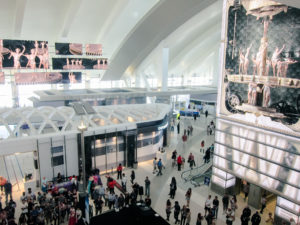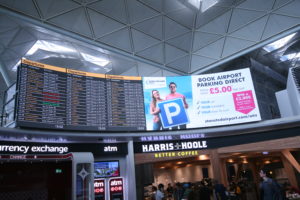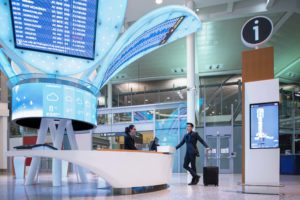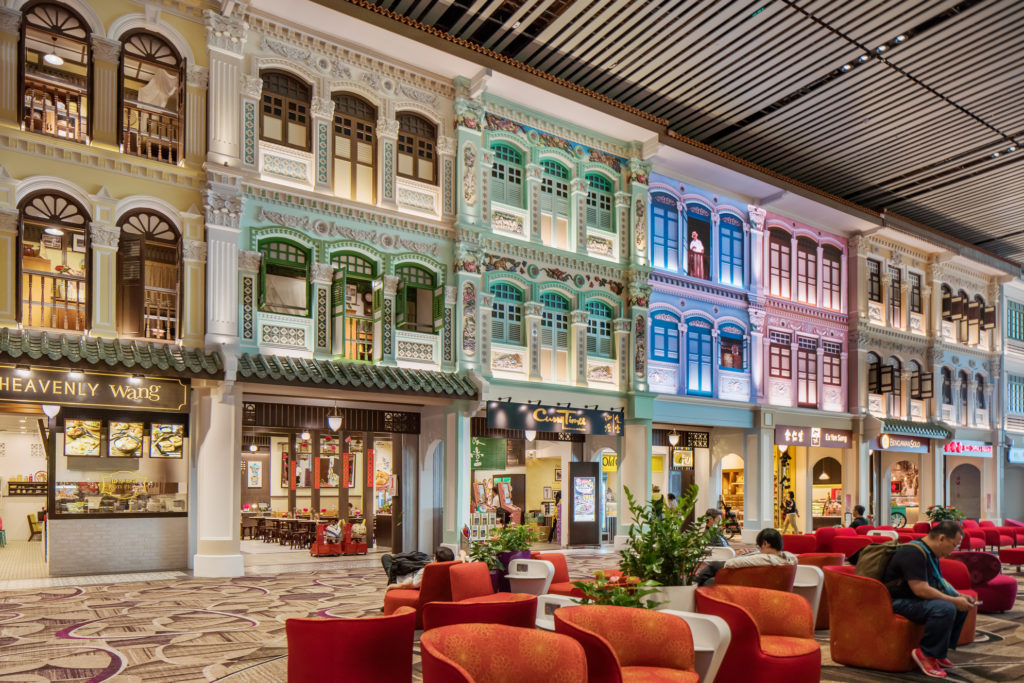Brad Grimes, senior director of communications for AVIXA, looks at how audiovisual experiences can be integrated with the terminal to reimagine the airport experience
The modern airport terminal is evolving dramatically, from a transit hub into an experience center, offering travelers new opportunities to hang out, shop, dine, work and relax. Key to this evolution are new audiovisual (AV) technologies that create immersive passenger experiences designed to entertain, engage and ease the passenger’s mind along their journey, while potentially increasing the airport’s non-aeronautical revenue. No longer just a means of communicating flight information and gate changes, today’s cutting-edge audiovisual solutions are the basis of a new in-terminal passenger experience that can turn dreaded wait times into moments of wonder, engagement and productivity.
Adding an artistic touch
Perhaps one of the more dramatic examples of how AV technology is transforming modern travel can be found at Charlotte Douglas International Airport in North Carolina. A 140ft-long display screen in the airport’s newly-refurbished Concourse A features renowned digital artist Refik Anadol’s unique ‘data sculptures’ that turn the airport’s invisible patterns of data into captivating and ever-changing artistic content. The same digital art is also synced and displayed on two additional LED displays located in the gates adjacent to the concourse.
This alluring installation, dubbed Interconnected’, is a part of a massive US$2.5bn airport-wide expansion and renovation project aimed at reimagining the airport experience. The display can be seen from both inside and outside the airport, cultivating its relaxing and hypnotic effect even before travelers enter Charlotte airport.
“The artwork is constantly changing and evolving as it responds to the ever-changing flow of data, creating a living snapshot of the invisible patterns that surround us as we travel to, from, and within Charlotte Douglas International Airport,” explained Anadol. “It’s quite mesmerizing and leaves a lasting impression.”

Flipping the script
Airports also are employing audiovisual technology as an engaging way both to welcome travelers to the location where they just landed and to say goodbye as they head back home. At Los Angeles International Airport (LAX), California, travelers arriving at the Tom Bradley International Terminal are greeted by a Welcome Wall — a video display standing 84ft-tall and 26ft-wide.
“We created a very big, ambient waterfall, very relaxing,” said Sakchin Bessette, co-founder and executive creative director of Moment Factory, the Montreal-based multimedia entertainment studio that worked with LAX on this content. “You’re coming off the plane, you’re just tuning into the city, and you want to be in a relaxed environment.”
Similarly, a 23ft-tall, 13ft-wide Bon Voyage Wall display delivers friendly messages targeted at departing travelers. The LAX displays are totally immersive, hitting all the viewer’s senses and creating a truly emotional draw.
“What we’re finding is that people are actually looking forward to their time in the terminal when they’re booked on an international flight through the Bradley Terminal at LAX,” said Andy Merkin, producer and director of Moment Factory’s Los Angeles office. “They’re looking forward to that experience, which is kind of flipping traditional transportation entertainment on its head.”
Ultimately, the goal is to turn conventional thinking on its head. Whereas many passengers may associate air travel with long lines and tense moments at security screening, audiovisual solutions help flip the script, turning what can be perceived as a stressful experience into a comfortable one.
At Singapore’s Changi Airport, a massive 230ft-wide by 33ft-high LED display features stunning 3D visuals produced by Moment Factory. The display is located in a security area, turning the normally tedious screening process into a far more engaging experience.
“With Terminal 4, we have sought to create an enjoyable and memorable travel experience for our passengers, from the facilities and services, to the environment and the visual elements within — especially in locations with higher footfall and longer dwell times,” explained Poh Li San, Changi Airport Group vice president in the airport’s Terminal 4 Program Management Office.
“The collection of art and entertainment formats in T4 were commissioned to be accessible to people of all ages and backgrounds, and it is a diverse blend of mediums, sizes and imagery that etches an inspiring first and last impression of their journey through T4.”
Li San speaks from a position of authority on the creative use of technology in airports, as Changi has been awarded ‘World’s Best Airport’ by the air travel review website Skytrax six years running. Ultimately, Changi wants to make travel easier, faster and more enjoyable for its customers through the use of audiovisual technology, providing them with more time and energy to explore the rest of the airport. As Li San points out, happy and relaxed customers tend to spend more on food and retail goods in the terminal.
Can you hear me now?
With innovative AV technology being deployed at leading airports, there is the very real need to ensure that sound emanating from those installations lands exactly where it’s meant to. Between screens showcasing news, sports, and other forms of entertainment — in addition to a multitude of kiosks and other interactive displays — directional audio prevents airports from becoming cacophonous spaces.
“I recently visited Reagan Washington National Airport and was amazed how I could walk up to a screen at a busy airport and, whether it was a news feed or sports feed, I could hear the audio for only that screen and not another nearby screen,” said Jeff Roach, manager of Fairbanks International Airport in Alaska. “[Directional] audio is really a great technique for not overloading a person and allowing them the experience that you’re trying to give them without all the distractions.”
Dallas/Fort Worth International Airport (DFW), Texas, also uses directional audio to improve TSA efficiency and traveler flow through its security checkpoints. Speakers positioned at the beginning of the security queue play music to relax travelers in the waiting line, while closer to the checkpoint another set of speakers deliver instructions to prepare travelers for the screening routine. As a result, according to officials, DFW passengers are better prepared and less stressed during the security process and TSA agents no longer yell instructions repeatedly – a win-win for both travelers and security workers.

Increasing non-aeronautical revenue streams
AV technology can also help drive non-aeronautical revenue. New, interactive digital signage offers a potentially more effective advertising platform. Leading-edge systems are enabling operators to replace static messages and images with attention-grabbing audiovisual content that can even respond to consumers’ mobile phone activity or shared information networks.
One such example is London Heathrow Airport, which installed digital billboards used by the UK’s global business publication, the Financial Times, to target passengers flying to six pre-selected US cities. The technology taps into Heathrow’s flight data via an application programming interface (API) to target relevant ads only at the passengers who are traveling to the chosen destinations.
“Airport advertising creates significant brand awareness and sales by helping advertisers reach highly coveted audiences such as the affluent frequent flyer and the key business decision makers around the world,” said Morten Gotterup, president of Clear Channel Airports, who recently concluded a consumer insights study that revealed airport advertising offers consumers a great opportunity to absorb and respond to brand messaging.
At London’s Stansted Airport, officials utilized audiovisual technology to deliver effective digital advertising. The airport deployed a 39ft-long, large-scale curved visualization system. The display not only helps travelers find their flight information, but its brightness and size offers a dynamic tool for advertisers to get their brand message across in ways that are more engaging to customers.
“Airports have a unique need to deliver important information right alongside advertising to tens of thousands of people every day,” said Joe Lloyd, vice president of global marketing for NanoLumens, which created the curved-screen technology. “Stansted Airport is making it easier for their customers to find their flight information as well as providing an advertising platform that can’t be missed.”

A journey as exciting as the destination
“The cool thing about technology is it allows you to integrate all the functional areas of passenger experience,” says Michael McElvaney, director at LeighFisher, which has been consulting for the aviation industry for more than 70 years. “From the moment they walk in the front door, you can actually track the passengers, follow where they’re going, and then you can use that information to determine how you want to best provide the experience for them.”
And when the airport itself is seen as an attractive destination, travelers are more likely to choose it the next time they book a trip.
“The intent is to get the anxiety out of the travel experience and just have a beautiful visual experience that makes passengers think about the destination they’re going to and have an enjoyable time while getting there,” said Alexandre Simionescu, principal and creative director at Montreal-based Float4, a studio that creates AV digital content.
Over the years, air travel, for many, has been characterized by discomfort, inconvenience and frustration. However, new advances in audiovisual technology, combined with creative uses of content, have airports reimagining the terminal experience by turning waiting into wonder and dread into delight. Their long-term goal: travelers who are more relaxed, engaged, and even entertained, and airports that run more smoothly and profitably.
Further reading:
To read a further case study on the use of state-of-the-art displays and audio-visual content at Platov Airport, in Rostov-on-Don, Russia, visit the September 2018 issue of Passenger Terminal World magazine here.
Bio:
Brad Grimes is senior director of communications for AVIXA, the Audiovisual and Integrated Experience Association. AVIXA represents the US$178bn global commercial AV industry and produces InfoComm trade shows around the world.

